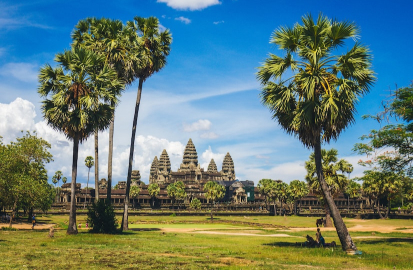The Golden Empire – Part 1: Funan and the Formation of Khmer
Humans have never understood everything about the Earth. What we know about the past are only remnants left on the planet.
Have we ever seriously asked the question: how many civilizations have existed on the blue planet? Not all civilizations were as lucky as Rome, with artifacts scattered all over the Mediterranean. There were civilizations that were destroyed to the point of being wiped out like Tay Ha, or simply forgotten like Funan.
Even we Vietnamese do not know much about Funan. Until the day our people moved south, we had never realized the existence of a brilliant civilization in the Mekong Delta. The dryness of the North African desert preserved the Egyptian civilization for 5000 years, but Funan was not so lucky.
Regarding the origin of Funan, we should be careful with the word “perhaps”. Nothing is certain. This ancient kingdom is so mystical that it seems to have been born from myth and ended like a myth. We know about Funan from scattered Chinese records from the time of the Northern domination and only confirmed its existence when Western archaeologists dug up its ruins. Funan existed at the same time as Rome, but while we know a lot about Rome, no one can be sure what the people of Funan looked like, what language they spoke, how they lived, even the name Funan is a provisional name based on Chinese books.
The characteristic of these countries influenced by Indian culture is that they did not record history like the Chinese. Instead, they carved it on stone tablets. Over thousands of years, the stone tablets were also damaged, thus making it even more difficult for us to trace the origin of Funan.
According to Khmer legend, Funan was founded by an Indian prince named Preah Thong and a naga named Neang Neak. This fertile land was the dowry of Neang Nek's father when he drained the water around Nokor Kauk Thlork island so that the couple and their children could live.
Through the above legend, we can see how much Indian culture influenced the land. The Mekong Delta was an ideal destination for Indian travelers and traders traveling from East to West. Indians brought Hinduism, laws, and Sanskrit, blending with the local culture.
According to Chinese history, the first dynasty of Funan was founded by a Brahman priest. Around the Three Kingdoms period, a Funan general named Pham Su Man founded a new dynasty. The Pham family existed until Sima Yan unified China. Existing at the same time as the great empires, Funan's commercial activities were very bustling.
So what caused the destruction of Funan?
The rise and fall of empires is a historical law. Although Rome existed for 1,500 years, it still ended in the hands of the Turks. History books say that it was the Khmer who ended Funan. However, the ancient environmental geologist Lieu Kim Sanh has put forward a shocking hypothesis. This civilization was probably destroyed by a "great flood". Not a flood like Noah encountered in the Bible, but a wave of sea encroachment on the Mekong Delta. Whatever the cause, it is certain that Funan was seriously weakened and the Chenla people rose up to become the masters of this land.
Chenla then divided into Luc Chenla and Thuy Chenla, consisting of many small states, fighting each other for centuries. They did not have a strong central government. That ended when Jayavarman 2 determined to suppress and unify the country, creating the Khmer empire.
If Funan has the mystical color of Atlantis, then Khmer has the majestic color of Egypt. Khmer history is long, but in general there are three most prominent kings:
- Jayavarman 2: the founding king.
- Suryavarman 2: the warrior king, the builder of Angkor Wat.
- Jayavarman 7: the king who conquered Champa, the builder of Angkor Thom.
From 802, Jayavarman 2 declared independence from the control of the Javanese court. The Khmer people created one of the largest empires in Southeast Asia. The Khmer empire spread over 1 million square kilometers, twice the size of France, three times the size of Germany and Vietnam, and five times the size of the current UK.
The Khmer's wealth came from abundant sources of wealth through trade. The empire produced rice to feed Southeast Asia. Up to 80% of the Khmer people participated in rice production or exchange. From here, the golden age of Khmer began.




